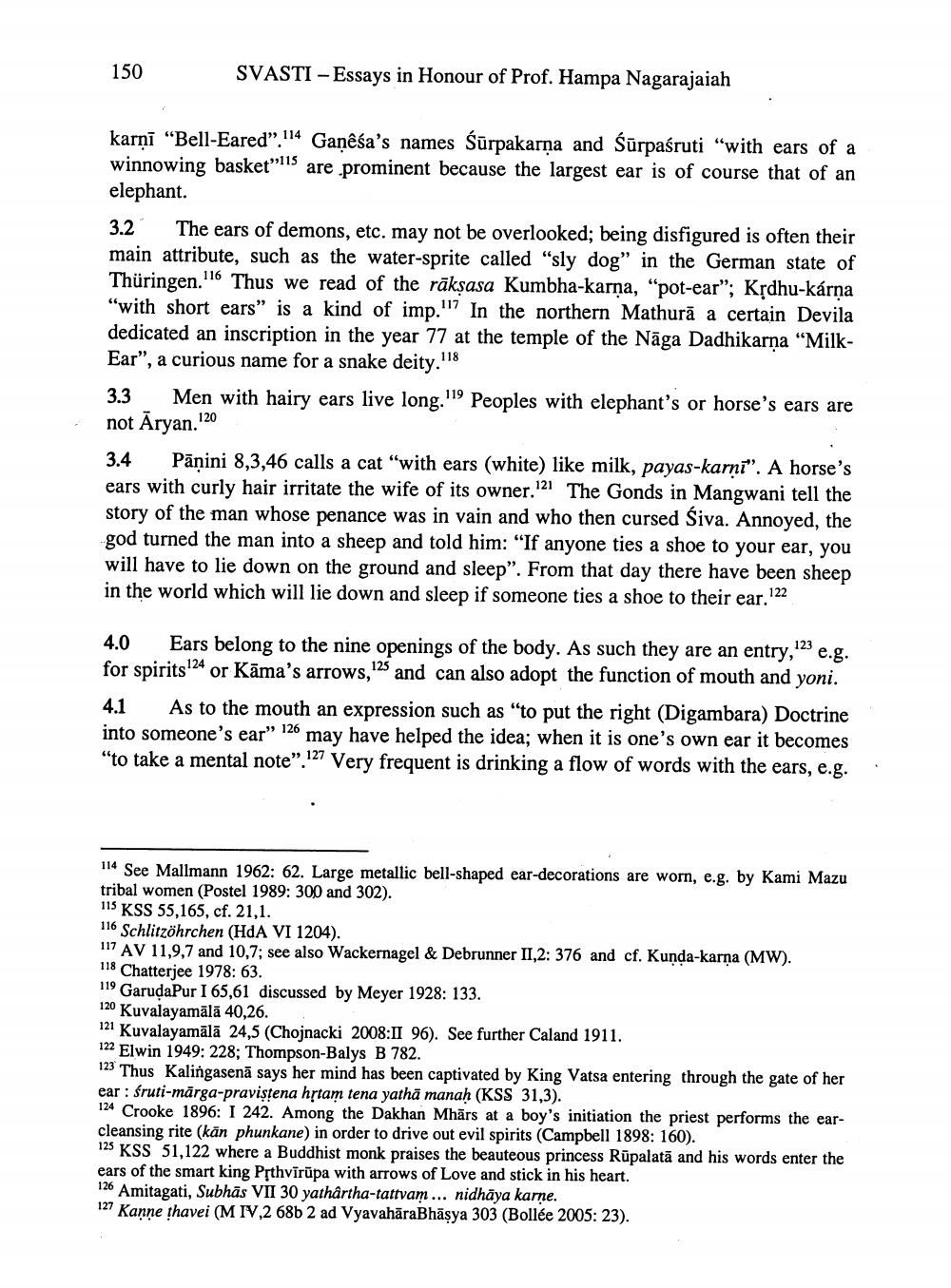________________
150
SVASTI – Essays in Honour of Prof. Hampa Nagarajaiah
karni “Bell-Eared”. 114 Ganêśa's names Sūrpakarna and Sūrpaśruti “with ears of a winnowing basket”lls are prominent because the largest ear is of course that of an elephant 3.2 The ears of demons, etc. may not be overlooked; being disfigured is often their main attribute, such as the water-sprite called "sly dog" in the German state of Thüringen.'16 Thus we read of the rāksasa Kumbha-karņa, "pot-ear"; Kļdhu-kárņa "with short ears" is a kind of imp."7 In the northern Mathurā a certain Devila dedicated an inscription in the year 77 at the temple of the Nāga Dadhikarņa “MilkEar", a curious name for a snake deity.'18 3.3 Men with hairy ears live long." Peoples with elephant's or horse's ears are not Āryan.120 3.4 Pāṇini 8,3,46 calls a cat "with ears (white) like milk, payas-karni". A horse's ears with curly hair irritate the wife of its owner.121 The Gonds in Mangwani tell the story of the man whose penance was in vain and who then cursed Śiva. Annoyed, the god turned the man into a sheep and told him: "If anyone ties a shoe to your ear, you will have to lie down on the ground and sleep". From that day there have been sheep in the world which will lie down and sleep if someone ties a shoe to their ear. 122
4.0 Ears belong to the nine openings of the body. As such they are an entry,123 e.g. for spirits!24 or Kāma's arrows,125 and can also adopt the function of mouth and yoni. 4.1 As to the mouth an expression such as "to put the right (Digambara) Doctrine into someone's ear” 126 may have helped the idea; when it is one's own ear it becomes "to take a mental note”.127 Very frequent is drinking a flow of words with the ears, e.g.
.
114 See Mallmann 1962: 62. Large metallic bell-shaped ear-decorations are worn, e.g. by Kami Mazu tribal women (Postel 1989: 300 and 302). 115 KSS 55,165, cf. 21,1. 116 Schlitzöhrchen (HDA VI 1204). 117 AV 11,9,7 and 10,7; see also Wackernagel & Debrunner II,2: 376 and cf. Kunda-karna (MW). 118 Chatterjee 1978: 63. 119 GarudaPur I 65,61 discussed by Meyer 1928: 133. 120 Kuvalayamālā 40,26. 121 Kuvalayamālā 24,5 (Chojnacki 2008:II 96). See further Caland 1911. 122 Elwin 1949: 228; Thompson-Balys B 782. 123 Thus Kalingasenā says her mind has been captivated by King Vatsa entering through the gate of her ear: śruti-mārga-praviştena hștam tena yathā manah (KSS 31,3). 124 Crooke 1896: I 242. Among the Dakhan Mhārs at a boy's initiation the priest performs the earcleansing rite (kān phunkane) in order to drive out evil spirits (Campbell 1898: 160). 125 KSS 51,122 where a Buddhist monk praises the beauteous princess Rūpalatā and his words enter the ears of the smart king Prthvīrupa with arrows of Love and stick in his heart. 126 Amitagati, Subhās VII 30 yathârtha-tattvam ... nidhāya karne. 127 Kanne havei (M IV,2 68b 2 ad VyavahāraBhāşya 303 (Bollée 2005: 23).




